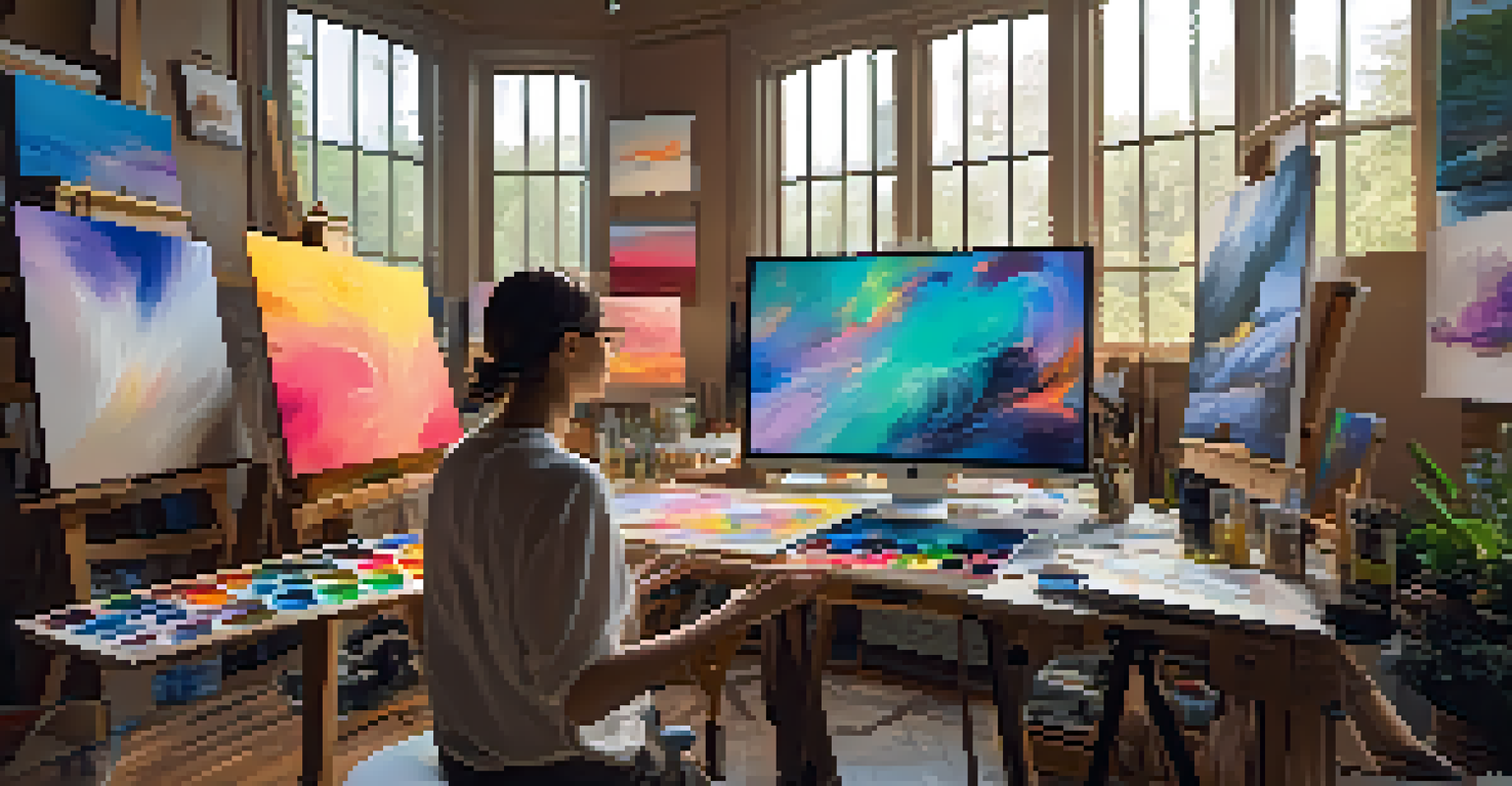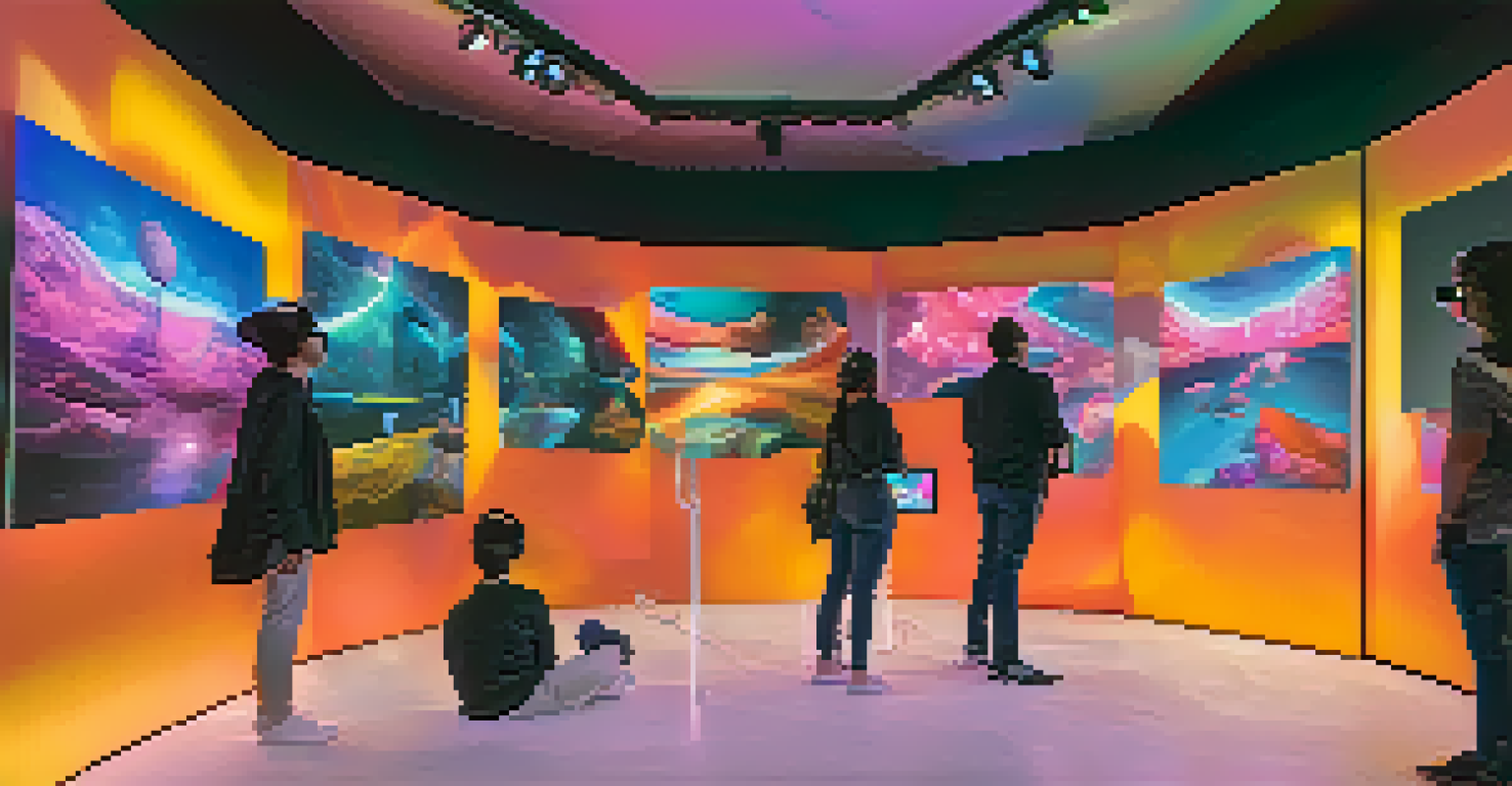The Intersection of Technology and Art: NFTs and Collectibles

What Are NFTs and Why Do They Matter?
Non-fungible tokens, or NFTs, are unique digital assets verified using blockchain technology. Unlike cryptocurrencies, which are interchangeable, each NFT is distinct, making them particularly valuable for artists and collectors. This uniqueness is what allows digital art to be bought, sold, and owned in a way that was not possible before.
Art is not freedom from discipline, but disciplined freedom.
The rise of NFTs has opened up new avenues for artists to monetize their work, bypassing traditional galleries and auction houses. Artists can now reach a global audience directly, offering their creations without intermediaries. This democratization of art sales is changing the landscape of the art market.
Moreover, NFTs provide a method for artists to earn ongoing royalties whenever their work is resold. This means that the original creator can benefit financially from future transactions, which is a significant shift from traditional art sales where the artist typically sees no further income after the initial sale.
The Impact of Technology on Artistic Expression
Technology has always influenced art, from the invention of the camera to digital painting software. Today, NFTs represent another leap forward, enabling artists to push the boundaries of creativity. Artists can create interactive digital pieces, animations, and even immersive virtual reality experiences that captivate audiences in ways traditional media cannot.

As artists explore this new medium, we see a blend of genres and styles emerge, encouraging experimentation and collaboration. For instance, musicians are releasing exclusive tracks as NFTs, while visual artists create stunning visuals to accompany their sound. This confluence of art forms enhances the overall artistic expression, enriching the cultural landscape.
NFTs Empower Artists and Collectors
NFTs provide artists with direct access to global audiences and ongoing royalties, transforming the way art is created and sold.
Additionally, technology allows for the creation of art that is responsive and adaptable. Artists can design pieces that change based on user interaction or environmental factors, offering a personalized experience that traditional art cannot provide. This innovative approach challenges our perceptions of what art can be.
Collecting in the Digital Age: A New Frontier
Collecting art has always been a passion for many, but the advent of NFTs has introduced a new dimension to this hobby. Digital collectibles, whether they be art pieces, music, or virtual items, can now be traded and showcased in online galleries. This shift enables collectors to display their collections to a global audience, expanding their reach beyond physical limitations.
The best artist has no conception that a marble block does not contain within it.
Platforms like OpenSea and Rarible have emerged, allowing collectors to browse, buy, and sell NFTs with ease. This accessibility has attracted a diverse group of collectors, from seasoned art enthusiasts to casual fans. The thrill of owning a unique digital asset adds an exciting layer to the collecting experience.
However, collecting NFTs also comes with its own set of challenges, such as ensuring authenticity and understanding the volatility of the market. As the NFT space continues to evolve, collectors must stay informed and cautious. Adopting a well-researched approach can help collectors navigate this innovative yet unpredictable landscape.
Environmental Concerns Surrounding NFTs
While the excitement around NFTs is palpable, it's essential to address the environmental concerns associated with blockchain technology. The energy consumption required for minting and trading NFTs, particularly on platforms like Ethereum, has raised alarms about its carbon footprint. This has sparked a debate about the sustainability of the NFT market and its long-term viability.
In response, some artists and platforms are exploring more eco-friendly alternatives. For instance, certain blockchains are designed to be more energy-efficient, using proof-of-stake mechanisms instead of the traditional proof-of-work systems. This shift toward greener practices is crucial for the future of NFTs and their acceptance by a wider audience.
Technology Redefines Artistic Expression
The integration of technology in art through NFTs allows for innovative creations, blending various art forms and enhancing interactivity.
As collectors and artists become more aware of these issues, there is a growing demand for transparency regarding the environmental impact of NFTs. This awareness is leading to a movement towards more sustainable practices within the digital art community, ensuring that creativity does not come at the expense of our planet.
The Role of Social Media in NFT Popularity
Social media has played a pivotal role in the rise of NFTs, serving as a platform for artists to showcase their work and connect with potential buyers. Platforms like Twitter, Instagram, and TikTok have become vital tools for artists, enabling them to build a following and engage with their audience. This direct connection fosters a sense of community among creators and collectors alike.
Influencers and celebrities have also jumped on the NFT bandwagon, further propelling their popularity. When well-known figures release their own NFTs, it draws significant attention and can lead to a surge in interest within the market. This intersection of celebrity culture and digital art has made NFTs a hot topic in mainstream discussions.
Moreover, social media allows for real-time conversations about art and culture, creating a dynamic environment where trends can emerge rapidly. Artists can share their creative processes, receive feedback, and even collaborate with others, all within the same digital space. This interaction enriches the NFT landscape, making it a vibrant community.
Future Trends in the NFT Art Scene
As we look ahead, the future of NFTs in the art world seems bright, with several emerging trends likely to shape the landscape. One of these trends is the increasing integration of augmented reality (AR) and virtual reality (VR) into the NFT experience. Imagine viewing a digital sculpture that comes to life in your living room or walking through a virtual gallery showcasing your favorite pieces.
Another trend is the rise of community-driven art projects, where artists and collectors collaborate to create unique experiences. These projects can foster engagement and create a sense of ownership among participants, blurring the lines between artist and audience. This collaborative spirit could redefine how we create and appreciate art.
Environmental Concerns in the NFT Market
The environmental impact of NFTs has sparked discussions about sustainable practices and the need for more eco-friendly blockchain alternatives.
Finally, as the NFT market matures, we may see more regulations aimed at protecting artists and collectors. Establishing clear guidelines will help build trust within the community and ensure that the interests of creators are safeguarded. This regulatory framework could pave the way for a more sustainable and equitable NFT ecosystem.
Conclusion: Embracing the New Era of Art and Collectibles
The intersection of technology and art through NFTs represents a revolutionary shift in how we create, collect, and appreciate art. This new medium empowers artists, offers exciting opportunities for collectors, and challenges traditional notions of ownership. As we navigate this evolving landscape, it's essential to embrace the potential of NFTs while remaining mindful of the accompanying challenges.
By engaging with this new wave of artistic expression, we can witness firsthand how technology enhances creativity and fosters community. As artists continue to innovate and explore the possibilities of NFTs, we can expect to see a broader range of artistic styles and experiences emerge. The future of art is here, and it's more inclusive and engaging than ever.

Ultimately, the journey into the world of NFTs is just beginning. Whether you're an artist, a collector, or simply an enthusiast, there's never been a better time to explore this dynamic intersection of technology and art. Let's celebrate this new era and the exciting possibilities it brings to the creative landscape.